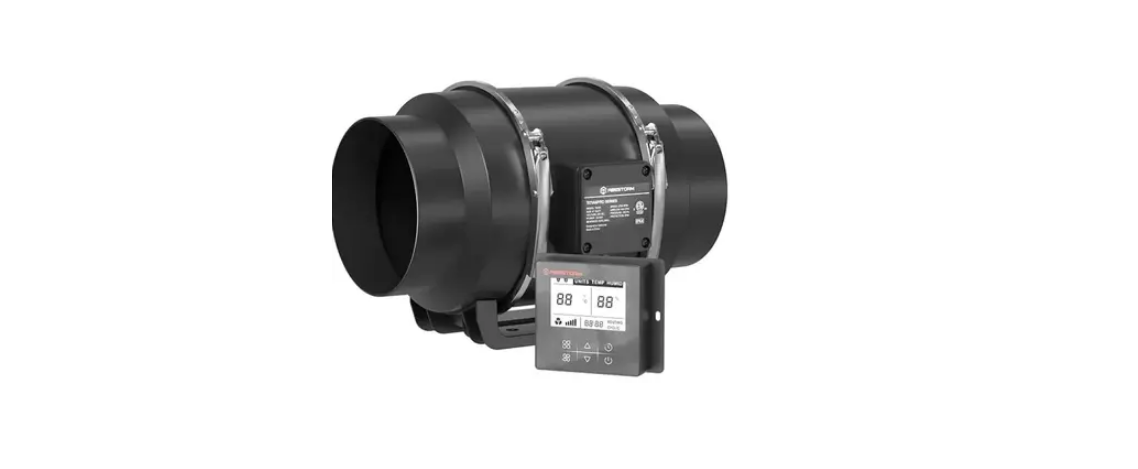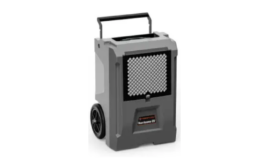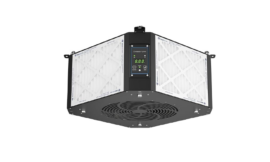ABESTORM T6-S6 Titian Pro 6-inch Inline Fan
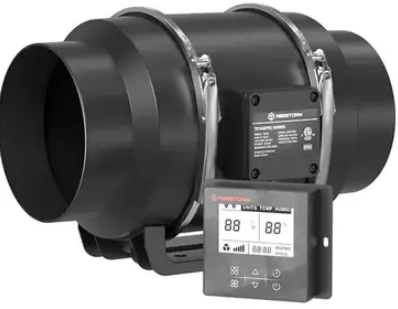
About Abestorm
Abestorm Crawl Space NeatyFresh Max allows for the free circulation of air on the porch and under the house. High moisture levels in the crawl spaces can lead to the decay and rot of wooden pillars that support the house, floor, joists, and beam pillars. Also, high humidity causes an increase in termite activity and the growth of fungi. Rust, which causes corrosion and leaks in metallic pipes, is also factored into the moisture level in your crawl space.
With our ventilation fan, radon gas from treated wood is expelled away. This gas and other odors can easily spread into the living room and cause discomfort. The NeatyFresh Max fan uses a humidity switch to control the fan to commence operation. The fan starts operating when the recorded humidity surpasses the selected value.
INSTALLATION POINTS
- The fan installation base (foundation, hanger) should have sufficient strength, stability, and durability.
- The connection between the inlet and outlet of the fan and the air duct should be equipped with flexible joints. Inlet duct, outlet pipe, and other devices should be supported separately, and firmly supported by the foundation or other components of the building, and the casing should not bear the weight of other components.
- When the fan is hoisted, the lifting should be firm and the position should be correct.
KEY FEATURES


- Plays the functions of exhaust, ventilation, heating, and cooling for the environment.
- Precision PWM control silent DC motor (low power energy saving / quieter).
- One-key control of 5-stage variable speed air volume.
- Memory function.
- Balanced ABS blades are washable.
- Well manufactured and lightweight.
- Easy to install and use.
- ETL professional certification
WIDE APPLICATIONS

The application of duct fans to hydroponic growth environments can increase the circulation of fresh air in the tent and reduce the concentration of carbon dioxide in the air. The ABS supercharger turbine blade design increases the air transport capacity of the fan by 30% and keeps the indoor air fresh.
When the machine is at a set point, it can monitor the external environmental conditions through a temperature sensor.
Make a heating/cooling reaction. Keep your environment in ideal condition. If moisture is present in the air for a long time, it is easy to cause mold to grow on the wall. When unmanned, the fan detects humidity and runs according to the program, easily absorbing moisture and humidity from the air.
TitianPro T6 connects the air intake and exhaust ports, and the flexible duct transports the old air to the outside through the vents, and at the same time, feeds in fresh air from the outside. It can effectively remove the odor present in the air.
APPLICATIONS
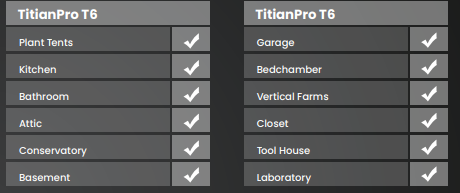
DIMENSION
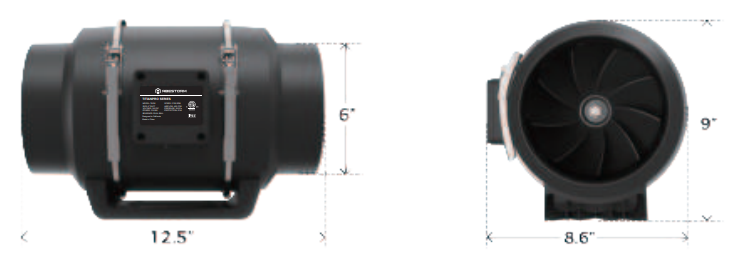
PRODUCT INFORMATION
- Item Model Number TitianPro T6
- Duct Ventilation Size 6 inches
- Operating Voltage / Power 110 V / 220 V, 50 / 60 Hz, 38 W
- Airflow / Pressure 402 CFM/ 300 Pa
- Temperature Range 32 – 122 °F
- Functioning Humidity Range ≤ 98%
- Weight (lbs) 4.85 lbs
- Item Dim (L×W×H) 12.5 × 8.6 × 9 inches
- Shipping Dim (L×W×H) 13.9 × 10.2 × 11.2 inches
- Sound Pressure Level (dBA) 32 dBA
- Motor DC
- Power Cord (ft) 9.8 ft
- Control Type Manual Control
- Mounting Type Floor Mount, Wall Mount, Hanging Mounting
- Recommended Uses for Product
- Exhausting, Ventilating, Conversion Heating Cooling
PERFORMANCE POSSESSION
TitianPro T6
- Use brushless DC PWM motor – precise speed regulation, reduced motor noise, energy-saving performance.
- Using a V-shaped hoop, easy and quick to disassemble, and at the same time has IP-44 sealing protection, high liquid resistance, and dustproof performance.
- The supercharged turbine blades provide high static pressure output, the exhaust effect is obvious, and the exhaust can be circulated, and the indoor and outdoor air can be circulated. Its quality is superior to any ventilator on the market.
- Double ball bearings and standard equipped with each factory product for dynamic balance test, so that the product runs quieter and has a longer life.
- TitianPro T series can be programmed and controlled as you like, and the parallel control of temperature and humidity environment and time system meets your unlimited needs. The controller has a memory function, and after the power is cut off, the power is restored to the last facility for operation.
Add: 8605 SANTA MONICA BLVD#79525 WEST
HOLLYWOOD, California, 90069 USA Tel: (888) 276-9833 Email: sales@abestorm.com
For More Manuals by Abestorm, visit LatestManuals
FAQs About ABESTORM T6-S6 Titian Pro 6-inch Inline Fan
How does an inline fan operate?
Air is drawn from the house and sent outside by inline fans, which are installed in line with the ducting. A remote-mounted fan is another term for an inline fan. Applications for inline fans include: Ventilating moist areas including kitchens, bathrooms, and laundry rooms
An inline cabinet fan: what is it?
To help with the ventilation and conditioning of an occupied room, inline cabinet fans flow air through ductwork. They are quieter than a typical ceiling fan and offer a versatile installation configuration thanks to their inline design and fully enclosed housing.
For what length of time can a fan run nonstop?
It is still preferable to turn off your ceiling fan when you are at work or away from home for a lengthy amount of time, even though it may operate for more than 24 hours. This will allow the ceiling fan’s motor to rest and save electricity consumption and costs.
Push or pull do inline fans operate?
When it comes to pushing air via ducting, inline fans are typically more efficient than pulling air. Thus, place the fan near the inlet end of the ducting rather than the output, especially for extended lengths.
What advantages do inline fans offer?
Bathroom fans with liners are designed to provide the best possible airflow, which efficiently manages moisture, humidity, and surface condensation while inhibiting the growth of mold and mildew. The majority of inline fans for homes are small and easy to install.
What is the power consumption of an inline fan?
But wattage-wise, these can fans, also known as booster fans, do not use as much energy as their active exhaust fan counterparts. When comparing 12-inch versions, a booster fan requires only 96W while an inline fan needs approximately 255W.
How much heat is the capacity of an inline duct fan?
The VIVOSUN 4-inch Inline Duct Fan 100 CFM can withstand temperatures as high as 140F/60C. The motor’s maximum operating temperature is 130°C/266°F.
Is an inline fan necessary?
In summation, an inline fan ought to be your first choice if you’re looking into a ventilation option and you have space above the bathroom.
How much power do fans require?
The average fan uses 50 to 100 watts per hour. Above all, this is an intriguing savings when you take into account that a typical air conditioner uses about 700 watts each hour. This implies that you will save money on your electricity bill in addition to avoiding having to install pricey air conditioning.
How long is a fan good for?
Generally speaking, a conventional ceiling fan can last up to ten years, although this will rely on its quality and your maintenance habits.
Is it possible to place inline fans vertically?
Additional configuration choices are provided by the Vent Axia ACM Range, which is one of the inline fans that can be installed vertically. Installers typically don’t need to “make good” when installing inline fans because all they need is a small ceiling hole for the extraction grille.
What distinguishes inline and axial fans from one another?
Axial fans can be classified as tube or vane types, whereas inline fans can be classified as centrifugal or mixed flow types. Although they may circulate a lot more air than inline fans, axial fans are frequently noisier and less effective. The most efficient axial form is vane axial, whereas mixed flow inline has the highest overall efficiency.
How frequently should an inline fan be operated?
It is advised that you leave your inline fan running continuously during the day and switch it off an hour after turning out the lights. Your plants will be able to flourish unhindered by this.
What distinguishes axial fans from inline fans?
Inline fans can be classified as mixed flow or centrifugal, whilst axial fans can be either tube or vane. While they can circulate a lot of air, axial fans are frequently less effective and louder than inline fans. Vane axial is the most efficient axial design, and mixed flow inline has the highest total efficiency.
When is the best time to run an inline fan?
We advise you to turn off your inline fan one hour after turning out the lights and to let it run the entire day. This will let your plants grow without interference.

